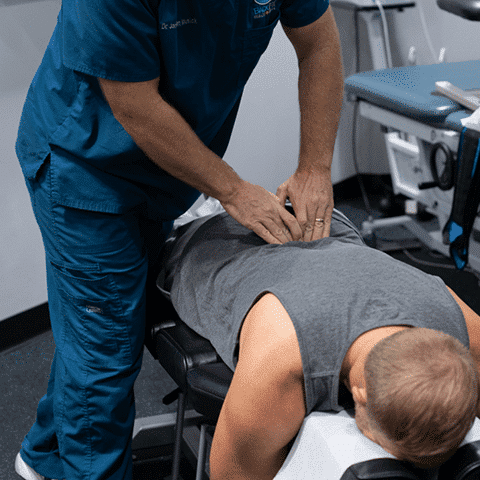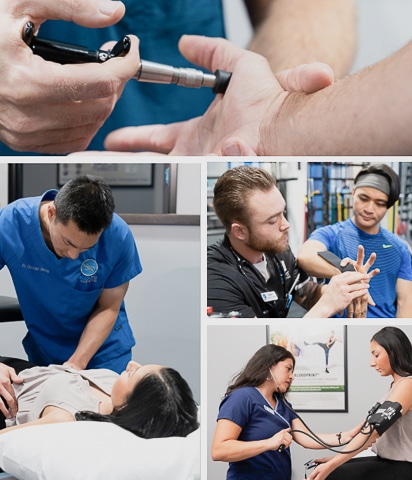Chiropractic Care

Appointment Inquiries
Functional Medicine Manipulation Under Anesthesia Massage Therapy Orthopedic Sports Medicine Physical Therapy Spinal Decompression Trigger Point Injections
Call us at: (877) 222-5348
Overview
Chiropractic care is a licensed health care profession focused on pain relief through the manipulation of the spine and joints (chiropractic adjustments) to support the nervous system. Chiropractors can also diagnose and prevent joint disorders, as well as provide soft tissue therapy, fitness coaching, nutritional advice, and more.
Symptoms Treated
"Pins and Needles", Arm, Elbow, Hand Pain or Numbness, Arthritis + Osteoarthritis, Auto Injury, Back Spasms, Bulging Disc + Herniated Disc, Carpal Tunnel Syndrome or Wrist Pain, Degenerative Disc Disease, Dizziness, Fibromyalgia, Fibromyalgia + Myofascial Pain, Headaches + Migraines, Hip Pain, Leg, Knee, Ankle, Foot Pain or Numbness, Neck Pain, Personal Injury, Pinched Nerves, Piriformis Syndrome, Sciatica, Scoliosis, Shoulder Pain, Spinal Stenosis, Spondylosis, Sports Injury, Temporomandibular Joint Pain (TMJ), Vertigo, Whiplash, Work Injury
Performed By
Doctor of Chiropractic
Complementary Treatments
Functional Medicine, Manipulation Under Anesthesia, Massage Therapy, Orthopedic Sports Medicine, Physical Therapy, Spinal Decompression, Trigger Point Injections
What is chiropractic care?
Chiropractic care is a licensed health care profession. Doctors of Chiropractic are primary care physicians that specialize in total well-being. Their focus is on spinal health. Doctors of Chiropractic are also known as DCs or simply Chiropractors.
Chiropractors specifically work on mechanical problems within the musculoskeletal system, especially the spine. This focus includes acute and chronic pain relief, as well as prevention of future pain and injury. Chiropractors primarily use a method called ‘adjusting’ to restore and improve joint function to promote a healthy nervous system.
The first priority for a Chiropractor is an exact diagnosis. If you have received a previous diagnosis from another doctor, we will work with it and rule out other issues. Chiropractors are also trained and licensed to provide soft-tissue therapies, lifestyle recommendations, fitness coaching, and nutritional advice.
Chiropractic care is considered conservative treatment as it aims to avoid unnecessary drugs and surgery. An estimated 50 million Americans see a chiropractor every year.
What is a chiropractic adjustment?
A chiropractic adjustment is a type of manipulation therapy. Specifically, an adjustment is a safe and controlled force applied to any joint in the body. Adjustments restore correct function and mobility. Chiropractic manual therapies can be performed by a DC or by Osteopaths. When performed on the spine, they are also known simply as spinal manipulation.
Accidents, falls, and over-exertion can put stress on your spine and other joints. Chiropractors often see patients after a car accident. However, most joint problems occur from everyday living and work. Poor posture, desk ergonomics, commutes, and poor sleeping positions more often create a misalignment in joints. Everyday life impacts the bones, soft tissue, and nervous system, and can lead to chronic pain.
Chiropractic adjustments reduce pain, increase range of motion, and improve performance. Most are done by hand, but some adjustments are done using specialized tools. Adjustments can be performed on almost any joint.
What are the different types of adjustment?
Diversified technique
The diversified chiropractic technique (DCT) is the most common adjustment technique, but there are dozens of chiropractic adjustment techniques. ‘Diversified’ is often the method most people think about when they think of a chiropractic adjustment. It is also known conversationally as a ‘manual adjustment.’
DCT is the most popular chiropractic adjustment. The diversified technique involves the application of a short (low-amplitude), quick (high-velocity) thrust over one restricted joint at a time. It is considered the most effective corrective technique.
Drop Table technique
Also known as the Thompson Technique, the drop table method is also very commonly practiced among chiropractors. It was researched and developed by Dr. J. Clay Thompson. Almost all chiropractors receive training in it.
It is a great alternative for people that prefer to not be manually adjusted.
The Thompson Technique almost always involves a Leg Length Inequality (LLI) test. This ‘leg check’ is done by looking at your feet to see if they are the same length. The Doctor might sometimes manipulate the joints of the hips, knee, or ankle as well. The purpose of this test is to determine postural distortions, especially in your pelvis. Studies show that it can be accurate within 3 millimeters.
The drop table technique utilizes a specialized, segmented table that moves up and down in sections. The drop table can be lifted up a few inches and dropped down 1 to 2 inches to make an adjustment.
Compared to the diversified technique, the force of an adjustment on a drop table is low-velocity. This difference between a high-velocity manual adjustment and a low-velocity drop table adjustment is due to the assistance of gravity.
The drop table technique is especially suited for adjusting patients with:
- Chronic low back pain
- Family chiropractic (kids + teens)
- Hip adjustments
- Kyphotic neck curve (“hunchback”)
- Pediatric adjustments (babies)
- Pregnant women
Activator method
Similar to the drop table technique, the activator method is also a great alternative for people that do not want to be adjusted manually.
The activator method chiropractic technique uses a small, hand-held, spring-loaded instrument. This instrument is called an activator. Compared to DCT, it delivers a low force impulse at very, very precise points.
The activator method is one of the most widely researched adjustment methods. An activator method adjustment is a quick thrust that is very gentle. An activator adjustment feels like a reflex test, like on your knee, without the reflex reaction.
It is especially suited for patients suffering from:
- Bulging discs
- Degenerative disc disease
- Herniated discs
- Inflammation at the joints
- Nerve conditions
- TMJ disorders
Children and seniors often appreciate the activator treatment for its gentle nature. It is especially useful in sensitive areas such as for arm, legs, jaw, and neck manipulations.
It can be used fully as an alternative for all regular spinal adjustments.
What symptoms and conditions do chiropractic adjustments treat?
People most often seek chiropractic care for low back pain, chronic neck pain, and headaches.
Chiropractic adjustments can also relieve pain and address many common health conditions, such as:
- Ankle pain
- Arm pain
- Arthritis & osteoarthritis
- Auto injury
- Back spasms
- Bulging & herniated disc
- Carpal tunnel syndrome
- Degenerative disc disease
- Dizziness
- Elbow pain
- Fibromyalgia
- Foot pain
- Hand pain
- Hip pain
- Knee pain
- Leg pain
- Leg length discrepancy
- Migraines
- Muscle spasms
- Myofascial pain
- Numbness or tingling
- Personal injury
- Pinched nerves
- Piriformis syndrome
- “Pins and needles”
- Sciatica
- Scoliosis
- Shoulder pain
- Spondylosis
- Sports injury
- Stenosis
- Temporomandibular joint pain (TMJ)
- Tension headaches
- Vertigo
- Whiplash
- Wrist pain
- Work injury
Many more conditions causing acute and chronic pain can also be treated by chiropractic care.
Those with spinal cord compression, inflammatory arthritis, or those taking blood-thinning medication are not candidates for chiropractic. If you have a history of cancer, talk to your oncologist to confirm if chiropractic adjustments are right for you.
What education and licensure do chiropractors need?
In order to practice as a primary doctor, DC’s are required to:
Chiropractic education includes coursework in biology, anatomy & physiology, supervised clinical experience assessing, diagnosing, and adjusting the spine and joints, and more.
Doctors of Chiropractic currently complete on average 372 more hours of classroom instruction, than Medical Doctors (MDs). DCs also collaborate and are trained to refer you to the appropriate specialist as needed.
At BackFit your personalized plan could include chiropractic adjustments, spinal decompression, physical therapy, massage therapy, medical services, pain management, and more. You’ll have access to multiple different specialists and providers under one roof.
What can I expect at my first chiropractic visit at BackFit?
In your first visit, we will:
- Obtain a detailed health history.
- Consult with you.
- Perform an examination.
- Obtain x-rays or other imaging in-house.
- Develop a working diagnosis.
Once a diagnosis is reached, we will provide options for various chiropractic treatment plans. It may include options for all of our services to get you pain free. If you have insurance, we will also confirm your chiropractic benefits before you start care. Or if you do not have insurance, we can discuss flexible cash plans with you.
Exercises and stretches from our physical therapists and soft tissue manipulation may be included with a massage therapist.
At BackFit, treatment is always a patient’s choice. You choose what adjustments you receive to what parts of your body and what methods are used for your adjustment. We only adjust you how you want to be adjusted.
Make an appointment Today!
Looking to learn more? Explore our locations, treatments, or our new patient offer below or contact one of the BackFit Family of staff to have your questions answered.


